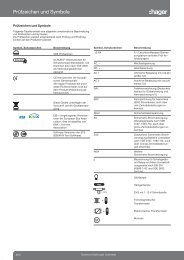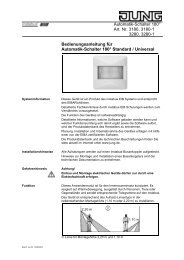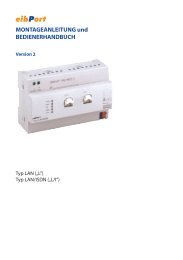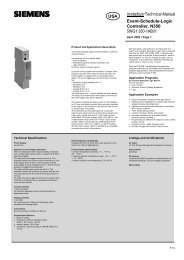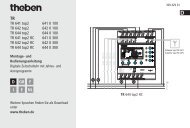Create successful ePaper yourself
Turn your PDF publications into a flip-book with our unique Google optimized e-Paper software.
4.2.4.12.3 Arming<br />
Arming/unarming the security areas<br />
The signalling system makes a distinction between security areas, the interior and the external<br />
skin. This distinction allows separate monitoring and arming of different building sections depending<br />
on whether authorised people are in them or not. For this reason, the panel allows internal<br />
and external arming (see chapter 4.2.4.12.1. Introduction and basic principles).<br />
A security area can only be armed when all the detectors assigned to this area are inactive and<br />
there is no fault in the system. The status of the signalling system and the individual security<br />
areas is always displayed on the system page of the signalling system (see picture 35).<br />
Arming and unarming takes place either directly on the panel or using KNX/EIB switching units,<br />
such as button sensors or button interfaces or keyswitches connected to binary inputs. There<br />
are also two separate 1 bit communication objects available for arming the bus, one for internal<br />
arming and one for external arming. The telegram polarity of these objects is fixed:<br />
"1" = Arm / "0" = Unarm.<br />
Arming can take place on the panel using the "Arm" and "Unarm" buttons on the system page of<br />
the signalling system. The panel automatically switches the function (Arm / Unarm) according to<br />
the current system status. Local arming using the buttons can be prevented in the parameter<br />
configuration of the ETS plug-in by hiding the buttons.<br />
Arming without arming delay:<br />
The area to be armed must be ready for arming. On internal arming, the signalling system only<br />
tests the external skin whilst on external arming, both the internal skin and the interior are tested<br />
for arming readiness. The detector list helps the system operator to detect active detectors<br />
which prevent arming readiness.<br />
Pressing the "Arm" button on the panel" or a "1" telegram to the "Internally armed" or "Externally<br />
armed" object causes the system to switch to the "Armed" status immediately.<br />
Arming with an arming delay:<br />
Arming with an arming delay is often used when the switching device<br />
(e.g. the panel or a button sensor) is installed in the secure area of the building. In this case, the<br />
system operator must be able to arm the system and still be able to leave the building in time.<br />
The arming delay can be configured separately, using the parameter of the same name in the<br />
ETS plug-in, for internal and external arming. Delay times of 0 s to 255 s can be configured. The<br />
setting "0 s" (presetting) deactivates the arming delay for the appropriate arming operation.<br />
When setting the time, a time reserve should be planned, so that the user is still able to leave<br />
the building to be secured correctly before actual arming.<br />
The delay time specifies after what time after a arming command (turning of the keyswitch or<br />
pressing of the "Arm" button on the panel) the system is actually armed. In so doing the signalling<br />
system only checks the arming readiness of the security areas after the delay time has<br />
elapsed.<br />
Example: the system is to be armed externally on the panel. For external arming, the system<br />
operator must leave the building. The front door is still open. Therefore, the panel displays "not<br />
ready". However, the operator can still carry out the arming command on the panel. The panel<br />
starts the arming delay. Within this time, the owner leaves the building and locks the front door.<br />
This makes the system ready for arming (no more detectors are active). When the delay time<br />
has elapsed, the signalling system checks for the arming readiness system status. If it is ready,<br />
the system arms immediately.<br />
Should, however, a detector still be active at the end of the arming delay, (e.g. front door not<br />
closed or window opened), then arming does not take place. Here too, the detector list helps the<br />
system operator to detect active detectors which prevent arming readiness before setting the<br />
arming command. If the system does not arm after the delay time has elapsed, then no acknowledgement<br />
will take place either (see next section).<br />
i An elapsing arming delay can be cancelled at any time by unarming.<br />
Order-No. 7574 00 1X<br />
Software "...590101"<br />
Functional description<br />
Page 119 of 222






